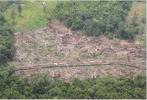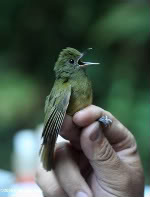With the world facing global warming and a biodiversity crisis, a new study in Conservation Biology shows that within 15 years logged forests—considered by many to be ‘degraded’—can be managed in order to successfully fight both climate change and extinction.
Studying regenerating forests in northeast Borneo, Dr. David Edwards from the University of Leeds, surveyed bird species in three different forests: a protected forest that had never been logged; a forest that had been logged and then actively rehabilitated over the last 15 years; and finally a forest undergoing natural regeneration after logging. Both forests were logged 20 years ago.
Through bird surveys, Edwards found that when a regenerating forest is supported by managed rehabilitation efforts, such as active tree-planting, it only requires 15 years for biodiversity to return to levels near those of unlogged areas. Naturally regenerating forest showed less diversity in the same time frame.
But in Southeast Asia many logged forests are quickly turned into plantations, such as palm oil and eucalyptus, whihc support little biodiversity when compared to forests.
Edwards says, “this [study] could act as a strong incentive to protect logged forests under threat of deforestation for oil palm and other such crops. Selectively logged rainforests are often vulnerable because they’re seen as degraded, but we’ve shown they can support similar levels of biodiversity to unlogged forests.”
Edwards further argues that his study proves carbon trading projects within rainforests, like REDD, should be linked directly to preserving biodiversity.
“Our research shows that it is possible to have both carbon sequestration and biodiversity benefits within the same scheme,” Edwards says. “There are now suggestions that carbon crediting and ‘biodiversity banking’ should be combined, enabling extra credits for projects that offer a biodiversity benefit. We believe this should be introduced as soon as possible, to ensure maximum support for rehabilitation schemes in the tropical rainforest.”
Related articles
Palm oil industry pledges wildlife corridors to save orangutans

(10/03/2009) In an unlikely—and perhaps tenuous—alliance, conservationists and the palm oil industry met this week to draw up plans to save Asia’s last great ape, the orangutan. As if to underscore the colloquium’s importance, delegates on arriving in the Malaysian State of Sabah found the capital covered in a thick and strange fog caused by the burning of rainforests and peat lands in neighboring Kalimantan. After two days of intensive meetings the colloquium adopted a resolution which included the acquisition of land for creating wildlife buffer zones of at least 100 meters along all major rivers, in addition to corridors for connecting forests. Researchers said such corridors were essential if orangutans were to have a future in Sabah.
Global campaign has planted 7 billion trees
(09/23/2009) The campaign to plant seven billion trees has achieved its goal, the United Nations announced Tuesday. 7.3 billion trees have been planted in 167 countries since the UN Environment Programme (UNEP) launched the initiative in 2006. The effort aimed to sequester vast amounts of carbon from the atmosphere while generating benefits for human populations and wildlife.
20% of land deforested in the Brazilian Amazon is regrowing forest
(09/06/2009) At least 20 percent land deforested in the Brazilian Amazon is regrowing forest, reports Brazil’s National Institute for Space Research (INPE).
Ecological restoration substantially boosts biodiversity and ecosystem services
(07/30/2009) A new analysis reports that ecological restoration generally deliver benefits for both conserving biodiversity and supporting human livelihoods, but does not completely reverse degradation caused by humans.
Polluted, degraded ecosystems can recover in less than a lifetime

(05/31/2009) Restoration efforts can return polluted or degraded landscapes to previous states in less than a lifetime, according to study Yale School of Forestry and Environmental Studies. The study rebuts a common assumption that ecosystem recovery takes centuries, even millennia.
Could engineering rainforests save the planet from global warming?
(01/21/2009) At the Smithsonian symposium entitled “Will the Rainforests Survive?”, leading tropical biologists vigorously debated current threats to the rainforest and what the future may hold. While climate change was identified as a leading threat to rainforests, many of the scientists argued that the tropics may also be the key to mitigating the impact of global warming.
Secondary forest should become new conservation initiative

(01/19/2009) “I want to convince you we need to go beyond primary forests to preserve biodiversity”, Robin Chazdon told an audience at the National Natural History Museum during a symposium on the tropics. Chazdon, a professor of ecology and evolutionary biology at the University of Connecticut, has been studying secondary growth forests for over eighteen years. Secondary forests are those forests in the process of regrowth after being used for agriculture or logging. In her study area of NE Costa Rica, many of these forests were converted to pastures in the 1970s and 1980s, but have since been abandoned. In her presentation Chazdon argued that to preserve biodiversity numerous types of human-impacted landscapes, such as secondary forest, require attention by the conservation community.